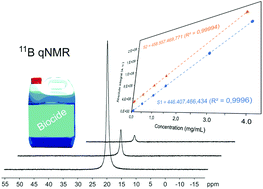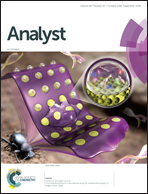Pushing the frontiers: boron-11 NMR as a method for quantitative boron analysis and its application to determine boric acid in commercial biocides†
Abstract
Quantitative boron-11 NMR (11B qNMR) spectroscopy has been introduced for the first time as a method to determine boric acid content in commercial biocides. Validation of the method affords a limit of detection of 0.02% w/w and a limit of quantification of 0.04% w/w, which are low enough to determine boric acid in commercial biocides. Other figures of merit such as linearity (R2 > 0.99), recovery (93.6%–106.2%), intra- and inter-day precision (from 0.7 to 2.0%), uncertainty (3.7 to 4.4%) and matrix effects were also evaluated. This method was successfully applied to determine boric acid in five different commercial biocides in a wide range of concentrations (<0.05 to 10% w/w) providing excellent results when they were compared with those obtained using inductively coupled plasma-mass spectrometry (ICP-MS). The suitability of this method for a fast and reliable quantification of boric acid in commercial biocide preparations has been demonstrated. The absence of the matrix effect allows the application of this validated method for the determination of boric acid in other matrices of diverse composition.



 Please wait while we load your content...
Please wait while we load your content...